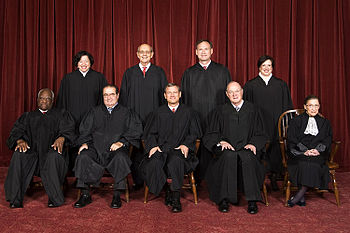WASHINGTON (AP) — The Supreme Court will once again confront the issue of race in university admissions in a case brought by a white student denied a spot at the flagship campus of the University of Texas.
The court said Tuesday it will return to the issue of affirmative action in higher education for the first time since its 2003 decision endorsing the use of race as a factor in admissions. This time around, a more conservative court is being asked to outlaw the use of Texas’ affirmative action plan and possibly to jettison the earlier ruling entirely.
A broad ruling in favor of the student, Abigail Fisher, could threaten affirmative action programs at many of the nation’s public and private universities, said Vanderbilt University law professor Brian Fitzpatrick.
A federal appeals court upheld the Texas program at issue, saying it was allowed under the high court’s decision in Grutter vs. Bollinger in 2003 that upheld racial considerations in university admissions at the University of Michigan law school.
The Texas case will be argued in the fall, probably in the final days of the presidential election campaign, and the changed makeup of the Supreme Court could foretell a different outcome. For one thing, Justice Samuel Alito appears more hostile to affirmative action than his predecessor, Justice Sandra Day O’Connor. For another, Justice Elena Kagan, who might be expected to vote with the court’s liberal-leaning justices in support of it, is not taking part in the case.
Kagan’s absence probably is a result of the Justice Department’s participation in the Texas case in the lower courts at a time when she served as solicitor general.
The challenge to the University of Texas program comes from Abigail Fisher, who filed a lawsuit with another woman when they were denied admission there. They contended the university’s race-conscious policy violated their civil and constitutional rights. By then, the two had enrolled elsewhere.
The other woman has since dropped out of the case and the state has said that Fisher is a senior at Louisiana State University whose impending graduation should bring an end to the lawsuit. But the Supreme Court appeared not to buy that argument Tuesday.
The Project on Fair Representation, which opposes the use of race in public policy, has helped pay Fisher’s legal bills. “This case presents the Court with an opportunity to clarify the boundaries of race preferences in higher education or even reconsider whether race should be permitted at all under the Constitution’s guarantee of equal protection,” said Edward Blum, the group’s director.
The project also issued a statement in Fisher’s name. “I hope the court will decide that all future UT applicants will be allowed to compete for admission without their race or ethnicity being a factor,” she said.
Most entering freshmen at Texas are admitted because they are among the top 10 percent in their high school class. Fisher’s grades did not put her in that category.
The Texas policy applies to the remaining spots and allows for the consideration of race along with other factors.
Texas had dropped affirmative action policies after a 1996 appeals court ruling. But following the high court ruling in 2003, the university resumed considering race starting with its 2005 entering class
Texas said its updated policy does not use quotas, which the high court has previously rejected.Instead, it said it takes a Supreme Court-endorsed holistic approach to enrollment, with an eye toward increasing the diversity of the student body.
Before adding race back into the mix, Texas’ student body was 21 percent African-American and Hispanic, according to court papers.
By 2007, the year before Fisher filed her lawsuit, African-Americans and Hispanics accounted for more than a quarter of the entering freshman class.
Fitzpatrick said two other states, California and Florida, use similar “top 10” plans, although California law explicitly prohibits the consideration of race.
“But the vast majority of schools that are selective are using affirmative action, though they don’t like to advertise it for fear of being sued,” he said.
The case is Fisher v. University of Texas at Austin, 11-345.
Subscribe to:
Post Comments (Atom)



No comments:
Post a Comment